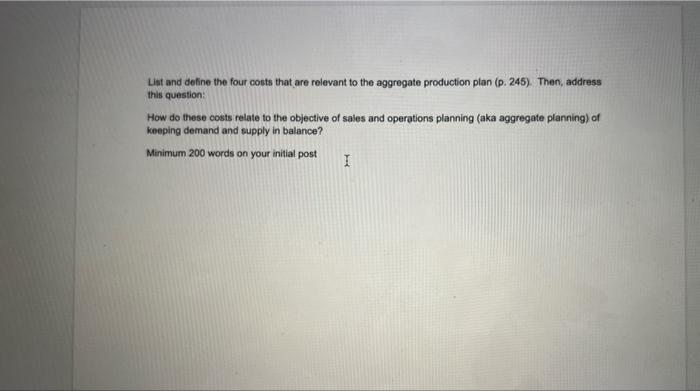List and define the four costs that are relevant to the aggregate production plan (p. 245). Then, address this question: How do these costs relate to the objective of saies and operations planning (aka aggregate planning) of keeping demand and supply in balance? Minimum 200 words on your initial post 2. Stable workforce-variable work hours. Vary the outpot by varying the number of hours wotked through flexible work schedales or onertime. By varying the number of work hours, you can match production quantities to orders. This strategy provides workforce continuity and avoids many of the emotional and tamgible costs of hiring and firing associated with the chase strategy. 3. Level strategy. Maintain a stable wotkforee working at a constant outpot rate. Shortages and surpluses are absorbed by fluctuating inventory levels, order backlogs, and lost sales. Eimployees benefit from stable work hours at the cost of potentially decreased customer service levels and increased inventory costs. Another concern is the possibility of inventoried products becoming obsolete. When just one of these variables is used to absorb demand fluctuations, it is termed a pure strategy; two or more used in combination constitute a mixed strategy. As you might suspect, mixed strategies are more widely applied in industry. Subcontracting In addition to these strategies, managers also may choose to subcontract some portion of production. This strategy is similar to the chase strategy, but hiring and laying off are translated into subcontracting and not subcontracting. Some level of subcontracting can be desirable to accomnodate demand fuctuations. However, unless the relationship with the supplier is particularly strong. a manufacturer can lose some control over schedule and quality. Relevant Costs Four costs are relevant to the aggregate production plan. These relate to the production cost itself, as well as the cost to hold inventory and to have unfilled orders. More specifically. these are 1. Basic production costs. These are the fixed and variable costs incurred in producing a given product type in a given time period. Included are direct and indirect labor costs and regular as well as overtime compensation. 2. Costs associated with changes in the production rate. Typical costs in this category are those involved in hiring, training, and laying off personnel. Hiring temporary help is a way of avoiding these costs. 3. Inventory holding costs. A major component is the cost of capital tied up in inventory. Other components are storing, insurance, taxes, spoilage, and obsolescence. 4. Bachordering costs. Usually, these are very hard to measure and include costs of expediting. loss of customer goodwill, and loss of sales revenues resulting from backordering. Budgets To receive funding, operations managers are generally required to submit annual, and sometimes quarterly, budget requests. The aggregate plan is key to the success of the budgeting process. Recall that the goal of the aggregate plan is to minimize the total production-related costs over the planning horizon by determining the optimal combination of workforee levels and inventory levels. Thus, the aggregate plan provides justification for the requested budget amount. Accurate medium-range planning increases the likelihood of (1) receiving the requested budget and (2) operating within the limits of the budget. In the next section, we provide an example of medium-range planning in a manufacturing setting. This example illustrates the trade-offs associated with different production planning strategies








